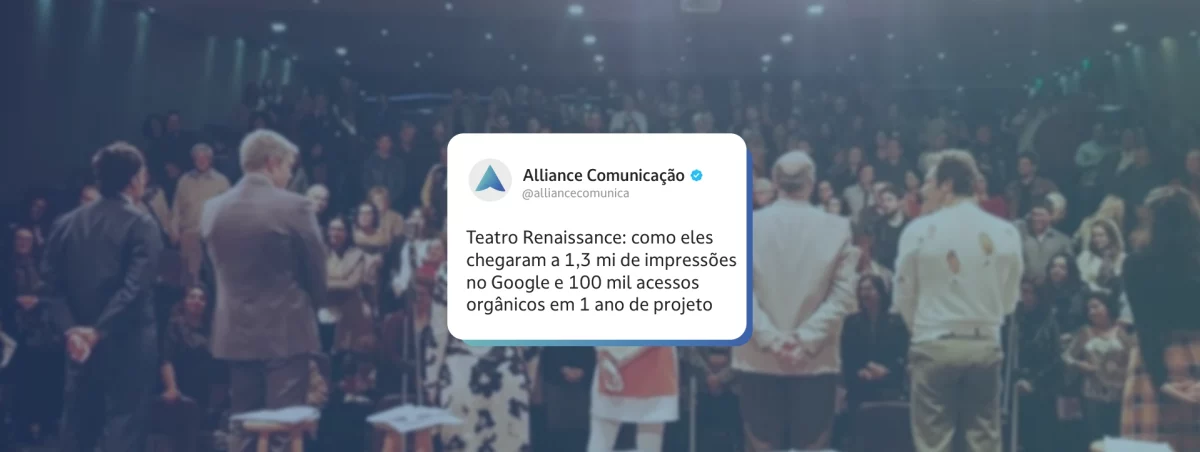Since prehistoric times, the human species has come together in communities with common goals – and this pattern remains to this day. Communication was one of the main starting points for the advancement of evolution. Through it, the different types of society were structured and standards of social coexistence were established. Today, we live in the era of real-time communication, of instantaneity, thanks mainly to the improvement of technology and greater access to it, reaching the phenomenon of digital influencers, which we will discuss later.
All this is the result of the search for new forms of social relations, structured around news and updated content, in a collaborative and complex environment, in a world of connected active individuals, who collectively produce knowledge and content.
Communication through the use of technologies, however, is not something very old in society. We can cite some examples, such as TV and radio. In these cases, however, communication takes place – or used to take place – from one to all. That is, from a single sender to multiple receivers. Since the emergence of these media, consumers have tried to maintain a dialogue channel with the media. Just as newspapers have a “Letter from Readers”, radio stations have always made room for listeners' calls. As technology evolved until the arrival of social media, this two-way street multiplied and gained another format.
The symbiosis between human beings and technology is already so great that it is rarely noticed, to the point where it is not possible to clearly discern where it begins and where it ends. This shows an incredible ability to adapt to new communication channels, which are emerging at an unprecedented speed.
These changes have impacted society in different ways, in business, consumption, and work, thus generating a new economic model and new challenges for companies. Parallel to the evolution of communication and society, marketing is also changing. Today, brands need to look at people as complete and complex beings, who have anxieties and concerns. Therefore, new values need to be incorporated into their messages: respect for differences, solidarity, transparency, interdependence, respect for others and the environment. Thus, within this context, new experiences are provided to touch the consumer's emotional side, thus naturally generating more trust and respect for him and society.
Read too: The 70 years of evolution of Marketing: from 1.0 to 5.0
All this leads to a more horizontal relationship model, through which consumers believe more in each other than in companies, the famous “word of mouth” as a reliable way of advertising. A more collaborative, innovative and authentic environment, in which people seek real values, involvement, feeling the brand with which they are interacting.
Relationships are increasingly direct, with people seeking to resolve their difficulties without relying on large institutions, such as governments or multinationals.
Digital marketing: social media as a purchase decision tool for Brazilians
The rise of social media has empowered the exchange between consumers, thus making the purchase decision process more susceptible to third-party opinions than ever before. Added to this is the fact that social media naturally generate a feeling of proximity to people with common interests and provide emotional rewards, such as prestige and a sense of belonging.
The importance of these networks can be translated into numbers. According to the Comscore survey, released in March 2023, Brazil has more than 131.5 million active accounts on social media. Of this total, at least 127.4 million are unique users, with a monthly average of 46 hours of connection per person.
This creates a context in which there is a significant portion of the Brazilian population accessing digital media, which bring emotional rewards, while algorithms group people with common interests. This favors the creation of communities, which are consolidated as interactions, comments, shares, reactions, among other resources that disseminate opinions, propagate ideas and even information.
However, even though these communities establish more horizontal forms of communication, which give room to multiplicity, it is necessary to reflect on the emergence of users with a higher level of social influence.
Today, with social media, this influence gains numbers and impacts that were previously unimaginable. If only a select group of people were opinion makers, currently, these media transform ordinary people into digital influencers, capable of impacting up to millions of people, guiding behaviors and trends, in addition to creating players within the digital world.
Understanding the particularities, complexities and influences of this new scenario is a vital issue for brands today. Understanding how this universe has been changing everyday life and the way people interact with brands has a direct impact on companies' marketing planning. In this sense, there are the challenges of keeping up with these changes in behavior, rethinking paradigms and mindsets without, however, losing sight of the essence of the brand.
Digital communication as a tool for more horizontal relationships with brands
It can be said that a new one has emerged, as a moment that demands courage from brands to review paradigms, question hierarchies, broaden horizons and reassess their relationships in a movement towards the future.
Increasingly, communication ceases to be just the set of actions that aim to make a message or advertisement common, and starts to add a set of platforms for exchanging information and establishing relationships. This revolution accelerated access to information, the sharing of ideas, and opened space for networking.
It is possible to identify how the maturation of the internet itself brought important innovations that reinforce the relational character of digital communication. This leads us to a more horizontal communication, which makes room for multiplicity.
The internet is the most incredible generativity tool ever created by man, because it allows the spontaneous generation of authorial, bidirectional and multidirectional content.
Social networks played a fundamental role in this scenario, as they are more attractive and easy to use, and because they have a huge potential reach. This horizontal relationship not only materialized but also became the basis of communication and marketing today, proving that the real revolution does not happen when society adopts new tools, but when it adopts new behaviors.
This wealth of information exchange, as well as the ease of collaboration and the development of social relationships, challenges individualistic attitudes.
Today we live in a totally new world, which has been transformed by the connectivity and transparency provided by the internet, opening space for content with information on culture, entertainment, sustainability, leisure, that is, a space for originality and authenticity.
According to a survey carried out by RD Station, 61.5% of Brazilian social media users use these channels to search for information about brands and products. The same study also reveals that 42% of TikTok users in Brazil use the platform to enjoy and follow videos from brands and companies they like.
Read too: The Generation Gap – Marketing to Baby Boomers and Generations X, Y, Z, and Alpha
Influencers as a bridge between brand and consumer
What drives a person to follow an influencer? The answers are diverse, but there is a basic aspect: identification with the tastes and ideas transmitted. In addition, we can say that they are good storytellers – “storytelling” –, with narratives that facilitate this proximity to the public, often creating niche markets with media potential, directly influencing consumer behavior. This makes digital influencers from specific segments, with fewer followers, as important as those with a large audience.
Thus, an interesting phenomenon is observed. Regardless of the volume of official information available about a brand or product, social circles continue to be one of the main sources of influence for the consumer, thus demonstrating how the contemporary public orients itself based on the opinion of third parties, whether observing a 2 star rating about a product or watching a follow-up influencer say they didn't like the experience. This all trumps marketing communications and even personal preferences.
Many classify digital influencers as autonomous media, with a strong and upright image, built from great legitimacy in the digital environment. It is even common for this legitimization to happen through exposure of their own personal life, the sincerity of everyday life – and these characteristics attract the interest of brands, which take advantage of this relationship of emotion, love and respect, to strengthen the credibility of advertising campaigns with the influencers of your target audience.
Thus, it is possible to define these digital influencers as the “word of mouth 2.0”. After all, relying on the opinion of friends, family, close people has always been one of the most used ways when deciding on a purchase.
Influence is an intrinsic concept. Every day, we are exposed to ideas, opinions, ideologies and attitudes by different actors in society. History is littered with influencers. We can mention Christ, Socrates, Plato, Napoleon, Einstein, Gandhi, and more recent ones like Mandela, Lincoln, Obama and Steve Jobs. These diverse divergent and complex influences condition society to change habits and attitudes, in the construction of a social “ethos”.
The term digital influencer is recent, but the phenomenon itself appears before web 2.0 with the emergence of bloggers (“Bloggers”), albeit in a more restricted environment. Then came the vloggers (“Vloggers”), which were later replaced by “Youtubers” – with the popularization of YouTube. And, only in 2015, the term digital influencer was born, which arises from the need to classify some people who were impacting on several different social media platforms. In 2016, the Oxford dictionary – one of the most important in the world – made the term “Youtuber” official in its pages.
Increasingly, the web has become an environment for opinions and participation of consumers and digital influencers, who, in a way, create their audiences around specific opinions and tastes, making this feeling of belonging even greater, creating a bond of proximity.
Relationship brands x digital influencers
Digital influencers have their own individual characteristics. It is necessary to identify and classify them within this digital universe. We can point out five main types of influencers:
Celebrity: famous person with great reach, but not relevant to the brand theme;
Celebrity with relevance: famous person with full affinity with the brand, who has a good chance of impacting large audiences and converting them;
Authority: technical person, respected in a given subject;
Journalist: works in traditional media and has great impact because of it;
micro influencers: people with fewer followers, but with a well-defined niche market.
Working with digital micro-influencers is one of the already consolidated trends in digital marketing, due to the ease of applying more segmented actions, which enable a higher conversion rate, often at a lower cost, compared to other profiles.
This scenario also implies a great concern for brands regarding the impact that their actions can cause. The web has not only magnified this impact, it has also diversified the risks. All these relationship tips have to maintain the brand's positive image, its reputation and a set of feelings such as respect, trust and admiration.
This is a time when experience and interactivity are essential points in companies' digital marketing strategies and, more than communicating correctly, it is necessary to learn how to relate to your audience in this new scenario, encouraging them to multiply the transmitted message. After all, each impacted person can talk about your brand to their 100, 200, 1,000 followers, or millions of other people if it goes viral.
In other words, digital prints this force of sharing and viralization very well, resulting in a scenario with relevant characteristics for the growth of companies' adherence.
At a time when many brands are already positioning themselves in a different way to reach this potential, it is common to see them engaged in some social cause, sharing the same anxieties and concerns as their consumers, showing that, in fact, they know and treat them as a complete and complex being, with mind, heart and soul. This requires a lot of dialogue, and social networks and digital influencers have played a key role in this dialogue between brand and consumer.
Therefore, the best way to maintain this dialogue is by delivering interesting, relevant and useful content to a clearly defined audience. On the other hand, it is important that these contents are loaded with the company's identity, often telling stories – "storytelling—, creating even deeper connections. This leads us to believe that digital marketing should no longer be considered just synonymous with sales and metrics, but rather the main aspect of a company to gain consumer trust, capable of breaking the blockade of traditional advertising.
It is not possible to say that traditional media will end, but they will certainly share space with these new models, with different levels of participation, in a constantly changing scenario. Furthermore, the innovations brought about by digital technologies do not invalidate previous technologies, but bring a new meaning to communication processes.
According to the AdSpend study by IA Brasil in partnership with Kantar Ibope Media, in 2022, digital advertising in the country, which includes partnerships with influencers, moved R$ 32.4 billion, representing an increase of 7% compared to the previous year.
This new approach to marketing, which combines online and offline between brands and customers, complements machine-to-machine connectivity with person-to-person touch to strengthen consumer engagement. A scenario that favors the creation of new spaces and narratives for brands to communicate with their consumers in a more relevant and engaged way.
The evolution of marketing concepts
A connected world, the marketing mix concept has evolved to accommodate more customer participation. The marketing mix – the 4Ps – must be redefined as the 4Cs: co-creation “co-creation”, currency “currency”, community activation “communal activation” and conversation “conversation”.
In this approach, co-creation is the new strategy for product development, involving customers in the design, achieving better success rates. The pricing concept has also been evolving, moving from a static price to a dynamic one, based on market demand and capacity. The channel has certainly undergone major changes, the concept of point-to-point distribution has a great advantage in this era of sharing economy, played by companies such as “Airbnb”, “Uber” etc.
Likewise, promotion has also been changing, moving away from a unilateral relationship – with companies sending messages to consumers - to a more open environment for consumers to react to these promotions. The proliferation of social media is one of the factors that allowed this reaction, promoting the emergence of platforms such as “TripAdvisor” and “Yelp”, creating an ideal environment for this conversation between consumer and brand.
At the same time that the key concepts of traditional marketing are evolving, the journey that the consumer takes to buy the product is also changing. The best known and most used model was the AIDA: attention, interest, desire and action. This model has undergone several interpretations during the last few years.
The latest model was presented by Derek Rucker, from Kellogg School of Management, which proposes the model of the 4As: assimilation, attitude, action and new action. In this newer model, the interest and desire stages are simplified into attitude. A new stage, new action, is added, intending to track the consumer's post-purchase behavior. This path reflects a personal and direct funnel-like side.
He then proposes a new approach to the 4As, due to the changes that the connectivity era has brought to the 5As process, which would be: assimilation, attraction, argument, action and apology. In the pre-connectivity era, a consumer determined his attitude towards brands. In the age of connectivity, the initial attraction of a brand is influenced by the community surrounding the consumer. In the pre-connectivity era, the purpose was retention and repurchase. In the age of connectivity, purpose is the willingness to champion a brand.
To understand brands, customers now actively connect with each other, developing research and advocacy relationships. Depending on the trend of the conversation, the connection can strengthen or weaken the brand's appeal. He also points out that the new consumer path is not necessarily a fixed funnel. It can be a spiral, and not necessarily go through the 5As. He can skip categories.
The main objective of marketing campaigns is to lead consumers from assimilation to apology, making them develop a feeling of strong loyalty to the brand, reflected in retention, repurchase and defense of the brand before their friends, the famous “I recommend”.
To optimize your marketing campaign, this classification into three main sources of influence: self, others and external, is known as the POE Zone. The external influence comes from sources unknown to the consumer, they are messages through advertising and other forms of communication.
This influence is still manageable and controllable for brands. The influence of others also comes from the external environment, which are usually people from close circles, such as friends and family, in the form of word of mouth. We can add to this classification the systems online of evaluation. Despite the brands' efforts, this influence is difficult to manage and occurs through community marketing, in which companies need to promote environments for discussion between the company and the communities. Own influence, on the other hand, comes from oneself, the result of past experiences and interactions with the brand.
The average consumer is generally impacted by all three influences, varying from market to market. Despite the variations, it is possible to state that consumers today rely more on the influences of others.
In addition, a survey by MindMiners points out that 81% of respondents assume that they read the comments and opinions of other users before purchasing a product for the first time, and 71% of them fully trust the reviews. Another important data is the negative impressions. According to the survey, they are the ones that most impact the purchase decision: 83% admitted that derogatory comments tend to be more relevant than positive ones.
Read too: The influential digital subcultures: youth, women and netizens
New consumer needs and influencers with the power to redefine market practices
The contemporary consumer has different needs from those consolidated by previous generations, such as sharing economy, instantaneity and integration omnichannel. Therefore, it needs to be impacted in other ways, including content marketing, customer relationship management strategy through social networks, intensification of the use of big data, among other things.
These new habits and technological advances brought new strategies in the marketing process. Today, the sale of products through virtual stores and subscription clubs is a reality, and brings agility and a completely different dynamic to the market. At the same time that these new forms of commercialization are more complex, they promote more competitiveness and, due to the possibility of covering a territory, also allow for greater business growth.
With this intensification of connectivity, relationships on social media and the speed of knowledge and/or information exchange have been directly impacting the way companies have been relating to their public. It's a very dynamic scenario, where everything is available in real time. They are new business models in differentiated narratives and fragmented, niche audiences, in environments stressed by the potential of different discussions/participations with different hierarchies of action.
The culture of niche communication and the creation of content strategies through the culture of participation and media convergence become premises for influencers to act, who in turn create a logic of content value to the point of making it relevant, shareable and engaged, reinforcing the ties between fan communities around these subjects on the network.
There is no doubt that digital influencers have redefined the practices and dynamics of contemporary markets by consolidating themselves as prominent figures in the digital environment. A 2021 Ibope Intelligence survey reveals that 52% of Brazilians who are on social media follow at least one influencer. However, it is worth reflecting: what does the “common user” absorb from these people? A survey by Invesp paints part of this, pointing out that 72% of consumers start to trust a company more after it is recommended by an influencer. Not only that. The survey also points out that 92% of respondents trust influencer reviews rather than traditional advertisements and celebrity recommendations.
And what explains this high power of influence? There is no single answer to this question. However, there are elements that help us understand this. As digital influencers have greater creative freedom, the message transmitted by them is naturally more original and authentic, thus increasing the chances of acceptance by followers.
However, this is far from meaning that the magic formula for brands is to start partnering with influencers. As with any other business decision, it requires strategy before, during and after the action, as well as thoroughly understanding why it makes sense for your business to partner with an influencer and, most importantly, understanding why it does. makes sense to your target audience.
Digital has brought us a world of data, however, it is necessary to transform them into information, from information to knowledge, from knowledge to insight, in order to arrive at a value for the brand. We are obese of information and anorexic of insights.



























